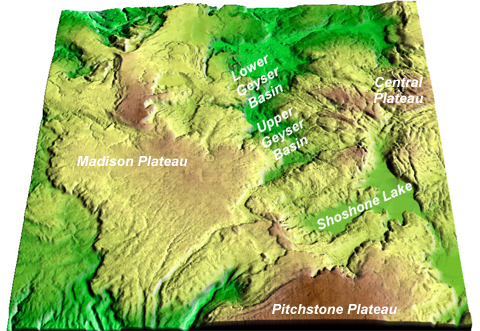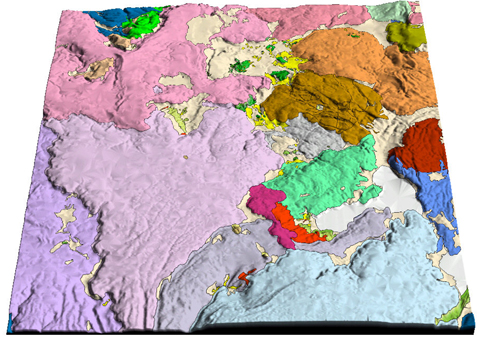Yellowstone National Park was established in 1871 as the world's first national
park. The Yellowstone area was born of violent volcanic eruptions (among the
most voluminous outpourings as that geologists have documented). Indeed, geophysicists
believe there is still a large magma chamber lurking beneath Yellowstone,
waiting to erupt again sometime in the future.
Within the park boundaries there are over 10,000 thermal springs and geysers.
These phenomena result from atmospheric precipitation that percolates into
the subsurface via fractures and faults common throughout the park.
As this water circulates through the subsurface, it becomes very hot because of its proximity to hot igneous rocks.
 <a onClick="window.open('/olcweb/cgi/pluginpop.cgi?it=jpg::::/sites/dl/free/0077373731/30425/VirtualVista1101.jpg','popWin', 'width=NaN,height=NaN,resizable,scrollbars');" href="#"><img valign="absmiddle" height="16" width="16" border="0" src="/olcweb/styles/shared/linkicons/image.gif"> (221.0K)</a>
<a onClick="window.open('/olcweb/cgi/pluginpop.cgi?it=jpg::::/sites/dl/free/0077373731/30425/VirtualVista1101.jpg','popWin', 'width=NaN,height=NaN,resizable,scrollbars');" href="#"><img valign="absmiddle" height="16" width="16" border="0" src="/olcweb/styles/shared/linkicons/image.gif"> (221.0K)</a>
Once the water becomes hot, it circulates back to the surface where it may
emerge as a thermal spring, creek, or geyser. The best-known geyser at Yellowstone
is Old Faithful, named for its predictable eruptions that draw thousands of
onlookers each day.
 <a onClick="window.open('/olcweb/cgi/pluginpop.cgi?it=jpg::::/sites/dl/free/0077373731/30425/VirtualVista1102.jpg','popWin', 'width=NaN,height=NaN,resizable,scrollbars');" href="#"><img valign="absmiddle" height="16" width="16" border="0" src="/olcweb/styles/shared/linkicons/image.gif"> (191.0K)</a>
<a onClick="window.open('/olcweb/cgi/pluginpop.cgi?it=jpg::::/sites/dl/free/0077373731/30425/VirtualVista1102.jpg','popWin', 'width=NaN,height=NaN,resizable,scrollbars');" href="#"><img valign="absmiddle" height="16" width="16" border="0" src="/olcweb/styles/shared/linkicons/image.gif"> (191.0K)</a>
The map above is a geologic map of a portion of Yellowstone National Park.
The different colors represent different rock units - in this case different
lava flows and volcanic ash deposits that erupted in this area over a period
of several hundred thousand years. Compare the colored rock units on this
map to the terrain of the park. Notice that many of the prominent plateaus
are formed from distinct volcanic flows. Geologists recognize these rock types
in the field by variations in their mineral composition and the spatial distribution
of the different rock units.
Points to Ponder1. Type "Yellowstone caldera" into your favorite Internet search engine and locate additional information about evidence of recent volcanic activity at Yellowstone National Park.
2. Yellowstone caldera formed from violent volcanic eruptions about 600,000 years ago. At this time, approximately 2,500 cubic kilometers of material was erupted. Use the Internet to find the area (in square kilometers) of your state, province, or country.
3. Divide 2,500 cubic kilometers by your chosen area to determine how thick Yellowstone volcanic debris would be if all of it was deposited within your area. Note that your answer is the thickness in kilometers. How thick is this deposit in meters? Convert meters to feet by dividing by 0.3048.For more information about the geologic history of Yellowstone National Park,
visit the National Park Service web site and plan your next vacation to see
the wonders of Yellowstone.

